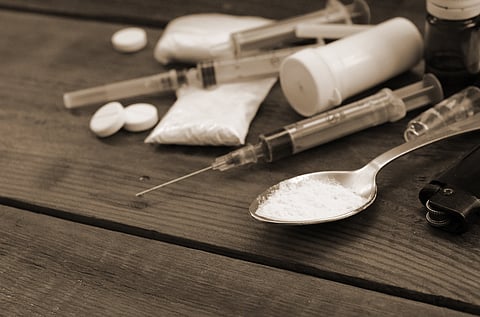Fentanyl is a synthetic opioid used to treat severe pain. But more than 150 people die every day from overdoses related to synthetic opioids like fentanyl, according to the U.S. Centers for Disease Control and Prevention (CDC).
Here is what you need to know about fentanyl, what it’s used for, what it does to you, side effects, drug interactions, withdrawal symptoms and why fentanyl is so dangerous.
What is fentanyl?
There are two types of fentanyl: pharmaceutical fentanyl and illegally made fentanyl (IMF). While both are synthetic opioids, IMF is responsible for the skyrocketing incidence of fentanyl overdose deaths.
But what does fentanyl look like? IMF is found in powder or liquid form. Liquid IMF can be found in nasal sprays or eye drops. The liquid form is often dropped on paper or small candy, leading to the potential for tragic deaths among children.
What is fentanyl used for?
Pharmaceutical fentanyl is used to treat post-op pain, cancer patients and others with severe chronic pain.
However, IMF has become a popular illicit opioid. One-hundred times more powerful than morphine and 50% more powerful than heroin, fentanyl can be injected, snorted or sniffed, smoked, taken as a pill or placed on paper. Illicitly produced fentanyl is sold alone or combined with heroin and other substances.
What does fentanyl do to you?
Fentanyl produces the following effects:
- Relaxation
- Euphoria
- Pain relief
- Sedation
- Confusion
- Drowsiness
- Dizziness
- Nausea and vomiting
- Urinary retention
- Pinpoint pupils
- Respiratory depression
How long does fentanyl stay in your system?
The effects of fentanyl last a few hours, but it can be detected in your urine, hair and blood far longer. Fentanyl can be detected in urine tests 24 to 72 hours after last use; in blood tests up to 48 hours; and in hair up to three months after last use.
Fentanyl dosage:
The dose for pharmaceutical fentanyl depends on how it is given and the patient’s pain level. Fentanyl patches offer a continuous dose and last 72 hours. According to the National Institute of Health, the normal IV dose for post-operative pain control is 50 to 100 mcg every 1 to 2 hours as needed.
Fentanyl side effects:
Side effects to report right away include:
- Skin rash, itching, hives, swelling of the face, lips, tongue or throat
- Slow or shallow breathing, shortness of breath, confusion, trouble staying awake
- Nausea, vomiting, loss of appetite, unusual weakness or fatigue
- Low blood pressure, dizziness, feeling faint or lightheaded, blurry vision
- Muscle stiffness
Fentanyl drug interactions
Fentanyl interacts with:
- Mifepristone (RU-486), a synthetic steroid
Other drugs that might cause interactions:
- Antiviral medications for HIV or AIDS
- Atropine
- Some antibiotics
- Some antifungal medications
- Some seizure medications
- Some Parkinson’s disease medications
- MAO Inhibitors
- Other narcotic medications for pain or cough
- Steroid medications like prednisone or cortisone
Make sure your physician knows about all of your medications before taking fentanyl.
Why is fentanyl so dangerous?
Fentanyl may be addictive, is often abused and is extremely dangerous. Here's why:
- Fentanyl is often slipped into other drugs, and the person taking the drug may have no idea.
- Fentanyl has a profound effect on breathing. A 2022 study in PNAS Nexus showed that fentanyl stops breathing (apnea) even before the patient is unconscious. “Opioids or other drugs taken during substance abuse may contain fentanyl in unknown yet significant proportions; the respiratory effects we describe here make clear that no amount of fentanyl would be safe in this context,” the study warned.
- Fentanyl has an incredibly tiny difference between a “safe dose” and a lethal dose, according to the CDC.
Fentanyl test strips are a low-cost method of helping prevent overdoses. They can be used on a tablet to see whether it contains fentanyl. While this is not a 100% safety net, it is one tool that can help prevent an overdose.
Signs of overdose
Recognizing Fentanyl overdose symptoms is critical and can mean the difference between life and death. These include:
- Small, pinpoint pupils
- Falling asleep or losing consciousness
- Slow, weak or no breathing
- Choking or gurgling sounds
- Limp body
- Cold, clammy skin
- Discolored skin (especially in lips and nails)
If you suspect an overdose, call 911. An injection of naloxone can reverse the effects of the drug if given soon enough. A Narcan nasal spray is available over-the-counter and anyone can administer it.
Fentanyl withdrawal symptoms:
Individuals addicted to fentanyl who reduce their dose or quit suddenly can experience withdrawal symptoms, including:
- Diarrhea
- Nausea and vomiting
- Rapid heart rate
- Muscle or bone pain
- High blood pressure
- Insomnia
- Anxiety
- Fever
- Sweating
- Chills
Resources
American Addiction Centers: How Long Does Fentanyl Stay in Your Body?
American Addiction Centers: Fentanyl Withdrawal Symptoms, Timeline, and Detox Treatment
Cleveland Clinic: Fentanyl Injection
Drug Enforcement Agency (DEA): Fentanyl
Drugs.com: Fentanyl
National Institutes of Health: Stat Pearls - Fentanyl
Oxford Academic PNA’s Nexus: An electroencephalogram biomarker of fentanyl drug effects
U.S. Centers for Disease Control and Prevention (CDC): Fentanyl Facts


